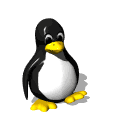|
The Linux project started in 1991, in a bedroom in Finland.
Linus Torvalds, then a college student, had written the outline
code for a new UNIX-style operating system kernel for his 386 PC,
which was then posted on an Internet bulletin board for others to
try out. Quite a few people became interested, and quickly started
contributing improvements to the code. The Linux movement had begun.

The penguin mascot, known as Tux, has now become a well-known icon
for Linux devotees around the globe. Tux has come to symbolise the
extraordinary growth of Linux, which has taken many people by
surprise. Perhaps the first milestone of note was the version 1.0
kernel, released in 1994. Not surprisingly, this was the first
Linux version to achieve more widespread usage, and the effects of
a growing user base and a rising profile started to snowball.
Things moved rapidly after the initial release, with kernels
1.2 and then 2.0 appearing by 1996. Advanced capabilities and
increasing hardware support helped Linux appeal to more and more
hobbyists who wanted to try it out. At the same time, several
Linux companies were formed, and began to market complete
distributions of the operating system, with full GUI desktops
and a collection of useful applications and utilities, most of them
from the GNU project. Linux began to achieve more significant
penetration as a small server platform, and among programming enthusiasts.
During the late nineties, the world started to notice,
and web sites, as well as magazine publications, sprung up all
over the place. More recently, the launch of the 2.2 kernel
in 1999, after three years in development, heralded the inclusion
of a new level of cross-platform support and advanced networking
technology in Linux. By now, thousands of talented programmers all
over the world were contributing to the code base.
The take-up of Linux on the desktop has been a little slower,
but with the advent of two highly capable, attractive and
user-friendly desktop environments, namely Gnome and KDE, many
people are at last beginning to see Linux as a viable challenger
to Windows. The mainstream distributions have come a long way
since the early days, and now offer intelligent installation
programs, vast quantities of high quality free software, and
excellent support networks for inexperienced users.
See a typical screenshot of KDE
|
Given the sophistication of Linux, and the effort involved
in developing it, how can it be free? There's no one answer
to this question, but recent history has demonstrated that the
open source model for software works admirably.
The idea is that no-one should own the software, or be able
to control it. A core belief is that anyone who uses the software
should have access to its source code, and be able to modify or
improve it as they wish, as long as they contribute those
improvements back to the open source community. This model is
formalised under the GNU General Public License, which covers
the Linux kernel itself, and virtually all the accompanying software
in most distributions.
From its humble beginnings, Linux has evolved into a cutting
edge, fully-fledged operating system, with all the sophisticated
power features you would expect from commercial UNIX offerings.
The newest Linux kernel, version 2.4, was released at the start
of 2001, and offers symmetric multiprocessing support for up to 32
CPUs, a multithreaded networking stack with full TCP/IP support,
new firewalling technology, advanced memory management, continued
legendary stability, improved peripheral support, and the ability
to run on 10 hardware platforms, including several 64-bit architectures.
Even more powerful features are being developed in the 2.5 development kernel
series, which has just been launched.
Linux is an enormously flexible operating system, in part
because you can custom-build a kernel with the features you
want. So far, Linux has proved most popular in server roles,
and already runs a third of the entire Internet's web servers,
steadily grabbing market share from established commercial rivals.
As the popularity of Linux grows exponentially, so does the number
of distributions available. The established companies, such as Red
Hat, face new competition in the form of an army of specialist
distributions that cater for the needs of specific user groups.
Whether you're after an all-purpose distro, a lightweight one for
an older system, or one that's tailored for graphics or programming,
there's highly likely to be one available already.
Of course, all this fragmentation is often cited as a disadvantage
of the platform. Linux is not one operating system, like Windows or the
other UNIX variants; rather it's a whole family of diverse operating
systems, built around the same kernel. However, an important standard
was recently published by an influential grouping of industry leaders.
Called the Linux Standards Base, it defines a common set of basic system
tools that should make up a compliant Linux distribution, and defines a
standard filesystem hierarchy. It is likely that the leading Linux vendors
will soon start adopting the LSB standard, which will make the lives of
developers much easier when writing applications to work on any Linux system.
|
![[LOGO]](interlock_logo.gif)